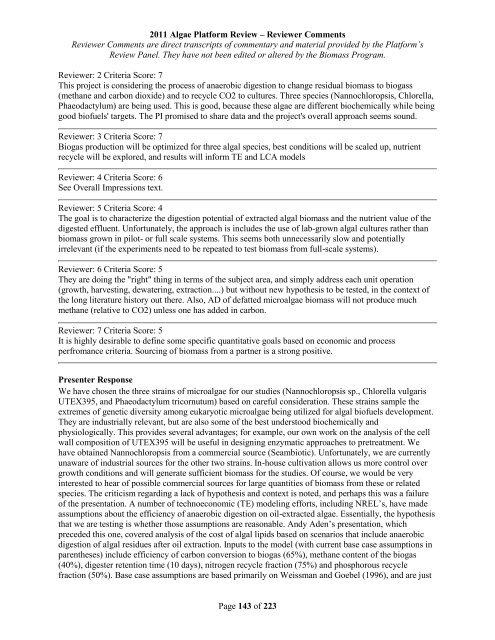Reviewer Comments - EERE
Reviewer Comments - EERE
Reviewer Comments - EERE
You also want an ePaper? Increase the reach of your titles
YUMPU automatically turns print PDFs into web optimized ePapers that Google loves.
2011 Algae Platform Review – <strong>Reviewer</strong> <strong>Comments</strong><br />
<strong>Reviewer</strong> <strong>Comments</strong> are direct transcripts of commentary and material provided by the Platform’s<br />
Review Panel. They have not been edited or altered by the Biomass Program.<br />
<strong>Reviewer</strong>: 2 Criteria Score: 7<br />
This project is considering the process of anaerobic digestion to change residual biomass to biogass<br />
(methane and carbon dioxide) and to recycle CO2 to cultures. Three species (Nannochloropsis, Chlorella,<br />
Phaeodactylum) are being used. This is good, because these algae are different biochemically while being<br />
good biofuels' targets. The PI promised to share data and the project's overall approach seems sound.<br />
<strong>Reviewer</strong>: 3 Criteria Score: 7<br />
Biogas production will be optimized for three algal species, best conditions will be scaled up, nutrient<br />
recycle will be explored, and results will inform TE and LCA models<br />
<strong>Reviewer</strong>: 4 Criteria Score: 6<br />
See Overall Impressions text.<br />
<strong>Reviewer</strong>: 5 Criteria Score: 4<br />
The goal is to characterize the digestion potential of extracted algal biomass and the nutrient value of the<br />
digested effluent. Unfortunately, the approach is includes the use of lab-grown algal cultures rather than<br />
biomass grown in pilot- or full scale systems. This seems both unnecessarily slow and potentially<br />
irrelevant (if the experiments need to be repeated to test biomass from full-scale systems).<br />
<strong>Reviewer</strong>: 6 Criteria Score: 5<br />
They are doing the "right" thing in terms of the subject area, and simply address each unit operation<br />
(growth, harvesting, dewatering, extraction....) but without new hypothesis to be tested, in the context of<br />
the long literature history out there. Also, AD of defatted microalgae biomass will not produce much<br />
methane (relative to CO2) unless one has added in carbon.<br />
<strong>Reviewer</strong>: 7 Criteria Score: 5<br />
It is highly desirable to define some specific quantitative goals based on economic and process<br />
perfromance criteria. Sourcing of biomass from a partner is a strong positive.<br />
Presenter Response<br />
We have chosen the three strains of microalgae for our studies (Nannochloropsis sp., Chlorella vulgaris<br />
UTEX395, and Phaeodactylum tricornutum) based on careful consideration. These strains sample the<br />
extremes of genetic diversity among eukaryotic microalgae being utilized for algal biofuels development.<br />
They are industrially relevant, but are also some of the best understood biochemically and<br />
physiologically. This provides several advantages; for example, our own work on the analysis of the cell<br />
wall composition of UTEX395 will be useful in designing enzymatic approaches to pretreatment. We<br />
have obtained Nannochloropsis from a commercial source (Seambiotic). Unfortunately, we are currently<br />
unaware of industrial sources for the other two strains. In-house cultivation allows us more control over<br />
growth conditions and will generate sufficient biomass for the studies. Of course, we would be very<br />
interested to hear of possible commercial sources for large quantities of biomass from these or related<br />
species. The criticism regarding a lack of hypothesis and context is noted, and perhaps this was a failure<br />
of the presentation. A number of technoeconomic (TE) modeling efforts, including NREL’s, have made<br />
assumptions about the efficiency of anaerobic digestion on oil-extracted algae. Essentially, the hypothesis<br />
that we are testing is whether those assumptions are reasonable. Andy Aden’s presentation, which<br />
preceded this one, covered analysis of the cost of algal lipids based on scenarios that include anaerobic<br />
digestion of algal residues after oil extraction. Inputs to the model (with current base case assumptions in<br />
parentheses) include efficiency of carbon conversion to biogas (65%), methane content of the biogas<br />
(40%), digester retention time (10 days), nitrogen recycle fraction (75%) and phosphorous recycle<br />
fraction (50%). Base case assumptions are based primarily on Weissman and Goebel (1996), and are just<br />
Page 143 of 223




